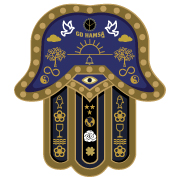Mission Statement: GDHamsa is a simple interactive platform for gd’s (good deeds). We are NOT affiliated with any political parties, governments, religions or regimes.
GDHamsa celebrates the practice of doing gd’s. GD’s for all humanity, for all life. How radical is that? Are you on board? All it takes to become a part of the community is to do and support the doing of gd’s.
If you are inclined, you can take it a further step by being seen in your gdhamsa, a universal symbol of goodness.
Please join us in getting out the vibe.
GDHamsa has reclaimed and rebooted this symbol from antiquity. In our view, in our time, the hamsa reflects hope, inspiration, good fortune, peace, good karma and above all, the doing of gd’s.
Our mission is to spread good news via the gd’s people do.
Help us help the world by supporting the symbol of all things good. Help us establish a global footprint for goodness. Help us to spread good news by being seen in your GDHamsa.
The hamsa hand has a variety of spellings: hamesh, hamsa, chamsa, chamza, and khamsa.
By: Ariela Pelaia
Updated April 23, 2019
The hamsa, or hamsa hand, is a talisman from the ancient Middle East. In its most common form, the amulet is shaped like a hand with three extended fingers in the middle and a curved thumb or pinky finger on either side. It is thought to protect against the “evil eye.” It is most often displayed on necklaces or bracelets, though it can also be found in other decorative elements like wall hangings.
The hamsa is most often associated with Judaism, but is also found in some branches of Islam, Hinduism, Christianity, Buddhism, and other traditions, and more recently it has been adopted by modern New Age spirituality.
Meaning and Origins
The word hamsa (חַמְסָה) comes from the Hebrew word hamesh, which means five. Hamsa refers to the fact that there are five fingers on the talisman, though some also believe it represents the five books of the Torah (Genesis, Exodus, Leviticus, Numbers, Deuteronomy). Sometimes it is called the Hand of Miriam, who was Moses’ sister.
In Islam, the hamsa is called the Hand of Fatima, in honor of one of the daughters of the Prophet Mohammed. Some say that, in Islamic tradition, the five fingers represent the Five Pillars of Islam. In fact, one of the most potent early examples of the hamsa in use appears on the Gate of Judgment (Puerta Judiciaria) of the 14th-century Spanish Islamic fortress, the Alhambra.
Many scholars believe that the hamsa predates both Judaism and Islam, possibly with origins that are entirely non-religious, although ultimately there is no certainty about its origins. Regardless, the Talmud accepts amulets (kamiyot, coming from the Hebrew “to bind”) as commonplace, with Shabbat 53a and 61a approving of carrying an amulet on Shabbat.
Symbolism of the Hamsa
The hamsa always has three extended middle fingers, but there is some variation to how the thumb and pinky fingers appear. Sometimes they are curved outwards, and other times they are just significantly shorter than the middle fingers. Whatever their shape, the thumb and pinky finger are always symmetrical.
In addition to being shaped like an oddly formed hand, the hamsa will often have an eye displayed in the palm of the hand. The eye is thought to be a powerful talisman against the “evil eye” or ayin hara (עין הרע).
The ayin hara is believed to be the cause of all of the world’s suffering, and although its modern use is hard to trace, the term is found in the Torah: Sarah gives Hagar an ayin hara in Genesis 16:5, which causes her to miscarry, and in Genesis 42:5, Jacob warns his sons not to be seen together as it may stir up ayin hara.
Other symbols that can appear on the hamsa include fish and Hebrew words. Fish are thought to be immune to the evil eye and are also symbols of good luck. Going along with the luck theme, mazal or mazel (meaning “luck” in Hebrew) is a word that is sometimes inscribed on the amulet.
In modern times, the hamsa is often featured on jewelry, hanging in the home, or as a larger design in Judaica. However, it is displayed, the amulet is thought to bring good luck and happiness.
Pelaia, Ariela. “The Hamsa Hand and What It Represents.”
http://learnreligions.com/what-is-a-hamsa-2076780
For a more detailed understanding of the hamsa, link below to Wikipedia:
